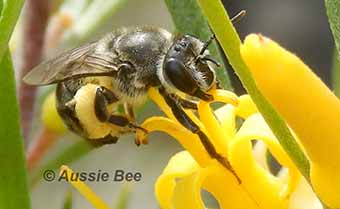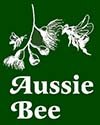CROP POLLINATION WITH NATIVE BEES
Aussie Bee > Pollination of Flowers > Crop Pollination
Australian farmers rely heavily on the introduced commercial bee, Apis mellifera, to pollinate their crops. However, we have over 1,700 species of native bees in Australia and for some crops our native bees may be better pollinators.
Crop Pollination with Native Stingless Bees
Australia has eleven species of stingless social native bees (genera Tetragonula - previously called Trigona -- and Austroplebeia). Stingless bees have been shown to be valuable pollinators of crops such as macadamias, mangos, watermelons and lychees. They may also benefit strawberries, citrus, avocados and many others.
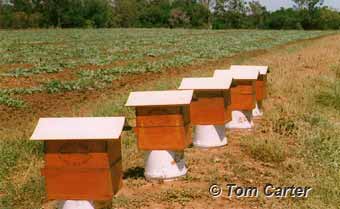
Tetragonula hockingsi stingless bees pollinate a crop of watermelons in Queensland. Photograph by Tom Carter.
Commercial pollination services with Australian stingless bees are already available and have produced impressive results particularly with macadamia and watermelon crops. Australian suppliers of stingless bees for crop pollination include:
-- Mark Grosskopf, Australian Native Bee Crop Pollination, Maryvale, Qld
Phone: 0438 623 734;
-- Steve Maginnity, north coast of NSW
Phone: 0404 831 659;
Email: steve@tanbc.com.au
Website: https://tanbc.com.au/
-- Lloyd Younger, Younger's Native Bees, Central Queensland
Phone: 0437 727 657;
Facebook Page: www.facebook.com/YNBYoungersNativeBees
Early studies at the University of Western Sydney demonstrated the excellent ability of stingless bees to work in confined areas such as glasshouses. Mark Greco of the University of Western Sydney also investigated the use of stingless bees for greenhouse capsicum pollination (read about Mark's amazing hive scanning method in Aussie Bee Online Article 7).
Research into the use of stingless bees for crop pollination in Australia is still under development but these bees show great potential! For more information, see the excellent book written by Dr Tim Heard: The Australian Native Bee Book.
Crop Pollination with Native Bee Species that can Buzz Pollinate
Other types of Australian native bees can also be great crop pollinators. Our native blue banded bees, teddy bear bees, great carpenter bees and metallic carpenter bees can perform a special type of pollination called Buzz Pollination. These bees grasp the flowers and vibrate them with their flight muscles, making the pollen shoot out of little capsules. This could make these bees ideal pollinators of crops which require this special kind of pollination, such as tomatoes, kiwi fruit, eggplants, blueberries, cranberries and chilli peppers. The commercial honey bee, Apis mellifera, cannot perform Buzz Pollination.
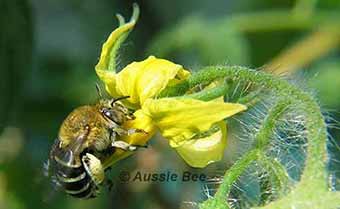
A Blue Banded Bee buzz pollinates a tomato flower inside a crop greenhouse. European Honeybees are unable to perform Buzz Pollination.
A research project at the University of Adelaide made substantial progress in finding ways to use blue banded bees for commercial greenhouse tomato pollination. The researchers discovered how to breed these native bees year-round in large numbers and demonstrated their effectiveness as greenhouse tomato pollinators. See: Blue Banded Bee Research Report.
Using native blue banded bees for greenhouse tomato pollination is a much better option than introducing European bumblebees for this purpose.
Find out more about crop pollination with blue banded bees in Aussie Bee Online! For example, Article 9 of Aussie Bee Online explains Melissa Bell's ground breaking study at the University of Western Sydney showing that blue banded bees are efficient glasshouse tomato pollinators; and in Article 8, Les Dollin explains how to make your own nest blocks to support the blue banded bees in your garden.
Crop Pollination with Wild Insects
Wild populations of insect pollinators, such as native bees, flies and beetles, also make a valuable contribution to crop pollination. A world-wide study by Lucas Garibaldi and colleagues in 2013 found that wild insects improved fruit yield twice as much as European honeybees did, and that the best yields of all were obtained when wild insects and European Honeybees pollinated crops together.
This important information means that if farmers encourage and support the natural wild insect pollinators that live on their land, they will get better yields from their crops. Here are some suggestions:
-- Areas of natural vegetation should be kept along the sides of crops and roads. Wild pollinators will be able to forage for nectar and pollen from natural flowers growing there, and they will be able to build their nests in the ground or in timber in these areas.
For instance, solitary Lasioglossum bees pick up a lot of dry pollen on their hairy bodies as they visit flowers. These wild native bees can be very good pollinators because dry pollen transfers easily to other flowers, helping the plants develop seeds and fruit. Lasioglossum bees nest in deep burrows in the ground. Areas of natural vegetation would provide wild populations of Lasioglossum bees with food and nesting sites.
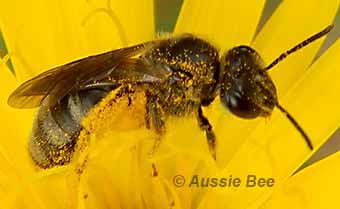
This solitary Lasioglossum bee has large amounts of dry pollen grains on her hind legs and her back. Dry pollen grains transfer readily to the female parts of flowers. So these kinds of bees can be excellent pollinators.
-- Additional bee-friendly flowers should be planted near crops to provide extra food for wild pollinators.
-- The use of insecticides that could kill wild insect pollinators should be limited as far as possible. If spraying is necessary, low-toxic formulas should be chosen and spraying should be done when wild pollinators are not active, such as at night time. It is also important to avoid insecticides drifting onto the natural vegetation areas by spraying at times when there is no wind.
Further Reading
-- AgGuide: Australian Native Bees
-- The Australian Native Bee Book

